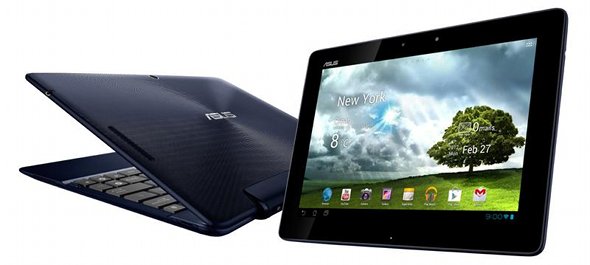ASUS Transformer Pad 300 Review
Introduction and Specifications
History has a habit of repeating itself; just as we had to burn through our review of the ASUS Eee Pad Transformer Prime in short order, we're on the fast track again with the new ASUS Transformer Pad 300 (TF300T). With a tablet this hot off the press and moving to retail channels so quickly, we wanted to get the word out to you as soon as the laws of physics would allow.
It’s a bloody shame, too, because we would have liked to spend more time poring over every feature and setting of this beautiful machine. Alas, our time with this tablet-come-netbook is short thus far but we'll promise to follow-up in the days ahead with more detail. Still, we managed to get in some good quality test time with the ASUS Transformer Pad 300, spending just about every waking hour running it through its paces in on our test track.

ASUS Transformer Pad 300
The 10.1-inch Transformer Pad 300 boasts a beautiful IPS display, Android 4.0 Ice Cream Sandwich, and NVIDIA’s Tegra 3 SoC (1.2GHz). Dave has already written extensively about both ICS and Tegra 3 within the context of one of this tablet’s predecessors, the ASUS Eee Pad Transformer Prime, so we’d recommend a quick read to brush up on those topics here and here.
The Transformer Pad 300 has three different performance modes--Power Saving, Balanced, and Performance--and each uses the processor differently. In Power Saving mode, cores 1 and 2 are clocked at 1GHz, with cores 3 and 4 at 0.72GHz and 0.6GHz, respectively. Balanced mode keeps all four cores humming along at 1.2GHz, but in Performance mode, core 1 ramps up to 1.3GHz while the other three remain at 1.2GHz.
Our tablet came with 32GB of onboard storage plus 8GB of ASUS Webstorage space, along with an SD card slot for expansion. (There will be a 16GB option, as well.) There’s a 1.2MP webcam on the front and an 8MP camera on the back; although the latter boasts some excellent features, including autofocus, but there’s unfortunately no flash.
The built-in mic performs nicely, capturing relatively clear audio with the Sound Recorder app and understanding commands for voice search reasonably well. ASUS didn’t skimp on audio quality with the Transformer Pad 300 either, with stereo speakers that are surprisingly good, pushing out sound with a dynamic range, clarity, and volume that we wouldn’t have expected from a tablet.
It’s a bloody shame, too, because we would have liked to spend more time poring over every feature and setting of this beautiful machine. Alas, our time with this tablet-come-netbook is short thus far but we'll promise to follow-up in the days ahead with more detail. Still, we managed to get in some good quality test time with the ASUS Transformer Pad 300, spending just about every waking hour running it through its paces in on our test track.

ASUS Transformer Pad 300
|
|
Operating System
Display CPU GPU Memory Storage Wireless Data Network Camera Audio Interface: Sensor Applications Battery Dimensions Weight Mobile Dock MSRP |
Android 4.03 10.1" LED Backlight WXGA (1280x800) IPS 10 finger multi-touch support 350nits NVIDIA Tegra 3 T30L quad-core CPU (1.2GHz) GeForce 12-core GPU, 3D Stereo 1GB DDR3 RAM 32GB onboard (as configured) + 8GB ASUS Webstorage space 802.11 b/g/n, Bluetooth 3.0, WiFi Direct 1.2MP front camera 8MP rear autofocus camera (1080p), large f/2.2 aperture Stereo Speakers with ASUS SonicMaster audio Built-in Mic Pad: 1 x 2-in-1 Audio Jack (Headphone / Mic-in) 1 x Micro HDMI 1.4a 1 x MicroSD Card Reader Mobile dock: 1 x USB2.0 port 1 x SD Card Slot G-Sensor, Light Sensor, Gyroscope, E-compass, GPS App Backup, App Locker, ASUS Sync, File Manager, MyCloud, MyLibrary, MyNet, Polaris Office, SuperNote, ASUS WebStorage, TegraZone 10 hours, 22Wh Li-polymer (pad only) 15 hours, 16.5Wh Li-polymer (dock) 263 x 181 x 9.7 mm (10.35 x 7.11 x 0.38 inches) 630 grams (1.39lbs), pad only Full 254mm QWERTY keyboard Android function keys 546g (1.2lbs) 16GB - $379, 32GB - $399, Optional Keyboard Dock - $149 |
The 10.1-inch Transformer Pad 300 boasts a beautiful IPS display, Android 4.0 Ice Cream Sandwich, and NVIDIA’s Tegra 3 SoC (1.2GHz). Dave has already written extensively about both ICS and Tegra 3 within the context of one of this tablet’s predecessors, the ASUS Eee Pad Transformer Prime, so we’d recommend a quick read to brush up on those topics here and here.
The Transformer Pad 300 has three different performance modes--Power Saving, Balanced, and Performance--and each uses the processor differently. In Power Saving mode, cores 1 and 2 are clocked at 1GHz, with cores 3 and 4 at 0.72GHz and 0.6GHz, respectively. Balanced mode keeps all four cores humming along at 1.2GHz, but in Performance mode, core 1 ramps up to 1.3GHz while the other three remain at 1.2GHz.
Our tablet came with 32GB of onboard storage plus 8GB of ASUS Webstorage space, along with an SD card slot for expansion. (There will be a 16GB option, as well.) There’s a 1.2MP webcam on the front and an 8MP camera on the back; although the latter boasts some excellent features, including autofocus, but there’s unfortunately no flash.
The built-in mic performs nicely, capturing relatively clear audio with the Sound Recorder app and understanding commands for voice search reasonably well. ASUS didn’t skimp on audio quality with the Transformer Pad 300 either, with stereo speakers that are surprisingly good, pushing out sound with a dynamic range, clarity, and volume that we wouldn’t have expected from a tablet.







